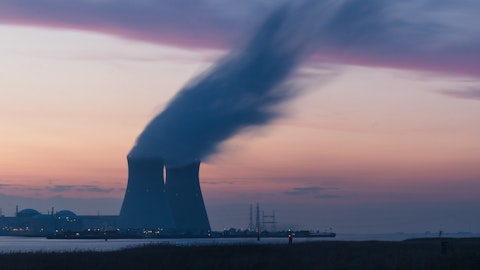Zach Davis: And Craig, just for some numbers that we’ve talked about before is basically with Stage 3, we’ll be a little over 55 million tons. And then with Train data, those are 3 million — that’s 3 million tons, but we’d hope just by adding those trains and some debottlenecking from Stage 3 and even maybe some from Train 1, 2, 3 there, we’re going to get to 6 months. And then as we think about some of the efforts that we’re doing and the development at Sabine, we’re thinking of things like oil reliquefaction of the gas. So that could add incremental capacity as well. So we’re pretty focused on the debottlenecking today. We’re still at 5 million tons per train and we’ll update you when we make more progress there.
Craig Shere: And the second question, more for Anatol. Beforehand agreement seems comparatively more vanilla than your prior SPL Stage 5 offtake agreements or related agreements. Would you say that the market is starting to — with higher interest rates, would worry about cost of capital and execution and large infrastructure projects the progress you’ve already made on scale Stage 5, your obvious historic execution and worries about peers are starting to make market off-takers look at saving expansion with greater value even without all the bells and whistles of DES or early cargoes and things like that.
Anatol Feygin: Yes, Craig, I will not take offense to your comments on behalf of the origination team. But as we’ve said in the past, we do expect, as we move forward, that the contractual support will largely rhyme with what we’ve done in the past. It will be a mix of the complexity in these transactions is, as you guys know, Stage 5 and specially Train 8 is quite far out. So there’s nothing that is as valuable in the market today as prompt volumes. You can see that obviously in the curve. And when we’re talking about a contract that will start in most likely early next decade and continue for 20 years, there’s complexity in that, right? So that is the — that is the key issue there. But you’re absolutely right on the second leg of your complement.
As Jack said, 3,000-plus cargoes perfect delivery track record at a time when other facilities in the U.S. globally — globally, the utilization rate for liquefaction is in the mid-80s. And of course, we don’t even count the Libya and the Yemen’s in those numbers, right? So our track record and the team’s performance is a standout relative to our peers globally, and that is being reflected in our commercial engagements.
Operator: We’ll go next to Brian Reynolds with UBS.
Brian Reynolds: I’ll keep it to one question on that will be our Zach, thanks for the clarification on the follow-up on the 9-train run rate guidance and the commentary there. But Cheniere has made a lot of money on optimization on the portfolio, whether it’s gas sourcing, regas or shipping. So just kind of curious if you can just update us if this is included in kind of the 9 train run rate guidance? And is there a way to kind of capitalize this number going forward, just given that it seems pretty ratable over the last 24 months? Or should we think about more cargoes going to Asia over the long term, maybe biting into some of that optimization.
Zach Davis: Sure. So basically, I mean, you can even look at like other revenue where the subchartering revenue comes in. And that goes all over the place quarter-to-quarter, just depending on the dynamics of how much length we have in our shipping portfolio to even sublease out. So these types of things they wouldn’t be in our run rate numbers whatsoever. They’re not even usually in our guidance until it’s locked in because we just can’t rely on it. It’s another reason why we wait for guidance in February because there is a good amount of variability for in-transit between ’23 and ’24. Those are the types of things we don’t want to count on with the guidance and somehow miss for just a timing reason. So that’s why we’ll come out with guidance in ’24.
And you could assume when we give you guidance, maybe on the high end, we’re taking advantage of some of the optimization, not just in subchartering out our length on the shipping side and using third-party volumes to deliver some of our DES deals. But upstream of the sites as well. We’ve been really successful this year, taking advantage of basis differentials in lifting margin and yes, enhancing that lifting margin that we’ve made at both facilities. So not baked into run rate guidance, and we’ll see where we are in February, but usually a tailwind to our guidance quarter-to-quarter.
Brian Reynolds: Great. Makes sense. I’ll leave it there. Thanks for the reminder on the CapEx to EBITDA swap for commissioning cargoes. Enjoy the rest of your morning.
Operator: At this time, there are no further questions. I will now turn the call back to management for additional or closing remarks.
Jack Fusco: I just want to thank everybody for their continued support of Cheniere and we’ll talk soon.
Operator: This does conclude today’s conference. We thank you for your participation.
Follow Cheniere Energy Inc. (NYSE:LNG)
Follow Cheniere Energy Inc. (NYSE:LNG)
Receive real-time insider trading and news alerts

